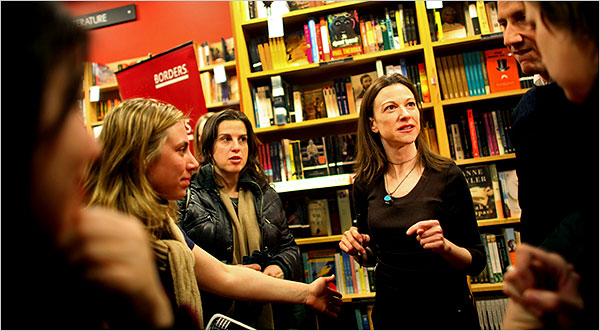Category Archives: Gender
“Political narratives are necessarily reductive, invariably gauzy and thus often misleading”
“Josephus’s invective against John and his rebel cohort should be read within a wider Roman discourse on transgressive gender”
Women bring a different perspective to investing
This gallery contains 1 photo.
Money has long been a traditionally male domain, sure, but historically so were medicine...“‘I work a lot with stay-at-home dads and men who work from home,’ he said, ‘and one thing I hear a lot is that, in theory, they’re really happy balancing flexible work with stay-at-home responsibilities…'”
Ian Kerner, a sexuality counselor and the author of “She Comes First,” sees couples struggle to find a ratio that works. “I work a lot with stay-at-home dads and men who work from home,” he said, “and one thing I hear a lot is that, in theory, they’re really happy balancing flexible work with stay-at-home responsibilities, while their wives are out working full-time in corporate jobs. But, at the same time, a common complaint is that Mom comes home and feels guilty for being away all day, and so much time has to be made up connecting with the children, who take first priority, that these dads feel lost in the mix.” In many couples, Kerner says, the wives start to feel disgruntled because their husbands get to see more of the kids, and the husbands, whose wives are controlling more of the spending, start to feel “financially emasculated.” Sometimes, he says, a vicious cycle begins: The husband feels marginalized and less self-confident, which causes the wife to lose respect for and desexualize him. Under these circumstances, neither is particularly interested in sex with the other.
Lori Gottlieb, “The Egalitarian-Marriage Conundrum”, The New York Times Magazine (9 February 2014), 33.
“Gender is no longer simply code for women or the feminine and its scholarship is no longer the province of females or even self-declared feminist”
Gender is no longer simply code for women or the feminine and its scholarship is no longer the province of females or even self-declared feminists. Indeed, gender has become a rather notably ambiguous signifier. Where this is acknowledged rather than covered over by tidy definitions, the ambiguity that attends the term is rendered productive, I believe.
Virginia Burrus, “Mapping as Metamorphosis: Initial Reflections on Gender and Ancient Religious Discourses”, in Mapping Gender in Ancient Religious Discourses, ed. Todd Penner & Caroline Vander Stichele (Leiden & Boston: Brill, 2007), 2.
“How do we read or map gender at such complexly determined and politically ambivalent sites?”
Studies of the ancient Mediterranean world have been powerfully enhanced by the current awareness of the complexity that the politics of identity both reveals and covers over. In particular, heterogeneity strives with universalism where the forces of empire and colonialism produce multiple and charged cultural contact zones. At the borderlines of oppression, not only resistance but also enormous creativity is encountered in the production of hybridized subjects. How do we read or map gender at such complexly determined and politically ambivalent sites? How, furthermore, do we read or map gender across religious affiliation, breaking through prior barriers of disciplinary practice that have separated scholars of Christianity, Judaism and pagan or “classical” antiquity, without thereby losing all traction on the particularity of religious cult or culture, shifty and overlapping as these mappings may prove to be?
Virginia Burrus, “Mapping as Metamorphosis: Initial Reflections on Gender and Ancient Religious Discourses”, in Mapping Gender in Ancient Religious Discourses, ed. Todd Penner & Caroline Vander Stichele (Leiden & Boston: Brill, 2007), 3-4.
A study “found that when men did certain kinds of chores around the house, couples had less sex”
A study called “Egalitarianism, Housework and Sexual Frequency in Marriage,” which appeared in The American Sociological Review last year, surprised many, precisely because it went against the logical assumption that as marriages improve by becoming more equal, the sex in these marriages will improve, too. Instead, it found that when men did certain kinds of chores around the house, couples had less sex. Specifically, if men did all of what the researchers characterized as feminine chores like folding laundry, cooking or vacuuming — the kinds of things many women say they want their husbands to do — then couples had sex 1.5 fewer times per month than those with husbands who did what were considered masculine chores, like taking out the trash or fixing the car. It wasn’t just the frequency that was affected, either — at least for the wives. The more traditional the division of labor, meaning the greater the husband’s share of masculine chores compared with feminine ones, the greater his wife’s reported sexual satisfaction.
Lori Gottlieb, “The Egalitarian-Marriage Conundrum”, The New York Times Magazine (9 February 2014), 28.
“Is religious discourse mapped in antiquity as a competition among cultural claimants of masculine perfection?”
…gender played a strong role in the agonistic articulation of nascent religious identity and difference, whether Christian, Jewish or “pagan.” Is religious discourse then mapped in antiquity as a competition among cultural claimants of masculine perfection? Alternatively, is it mapped as an irruption of ambivalently subversive or counterhegemonic genders to which empire paradoxically gives rise? I would answer both of these in the affirmative. Again, we face an ambivalence that is mapped across our texts and theirs.
Virginia Burrus, “Mapping as Metamorphosis: Initial Reflections on Gender and Ancient Religious Discourses”, in Mapping Gender in Ancient Religious Discourses, ed. Todd Penner & Caroline Vander Stichele (Leiden & Boston: Brill, 2007), 9-10.
How “notions of masculinity functioned to articulate the strength of the emperor and state” in Rome
What matters, in this propagandistic game, is not the actual sexual proclivities of a particular emperor but the extent to which notions of masculinity functioned to articulate the strength of the emperor and state, regardless of which imperial family occupied the palace in Rome.
Jason von Ehrenkrook, “Effeminacy in the Shadow of Empire: The Politics of Transgressive Gender in Josephus’s Bellum Judaicum,” The Jewish Quarterly Review 101:2 (Spring 2011), 161.


